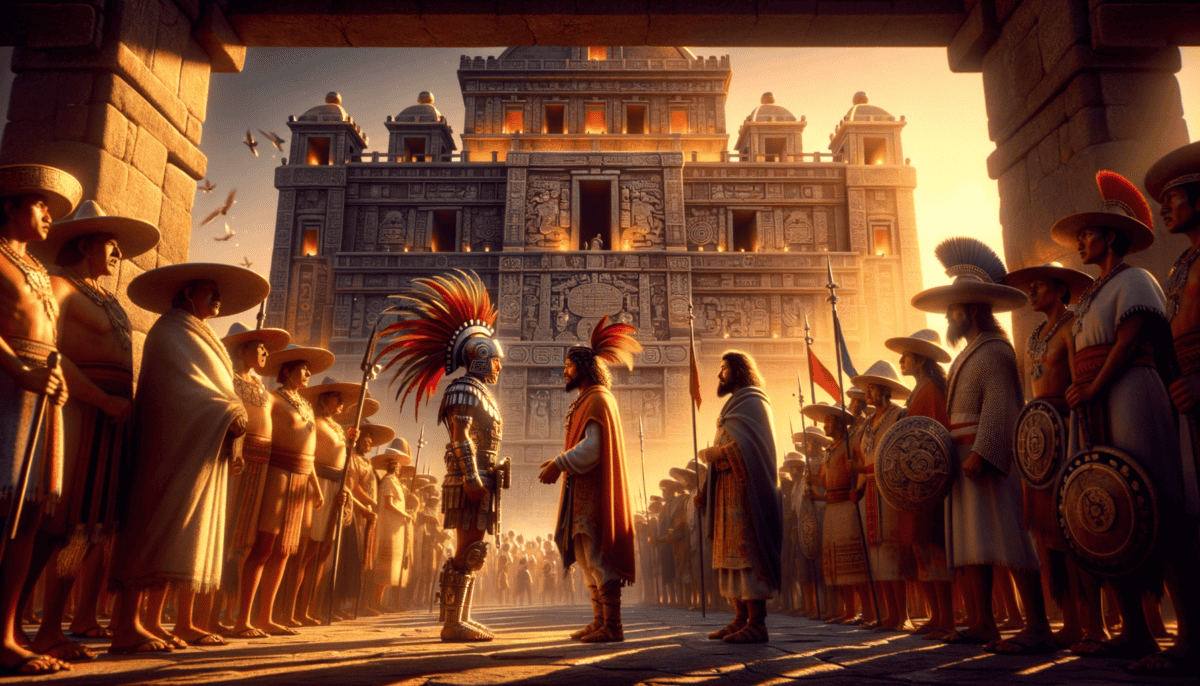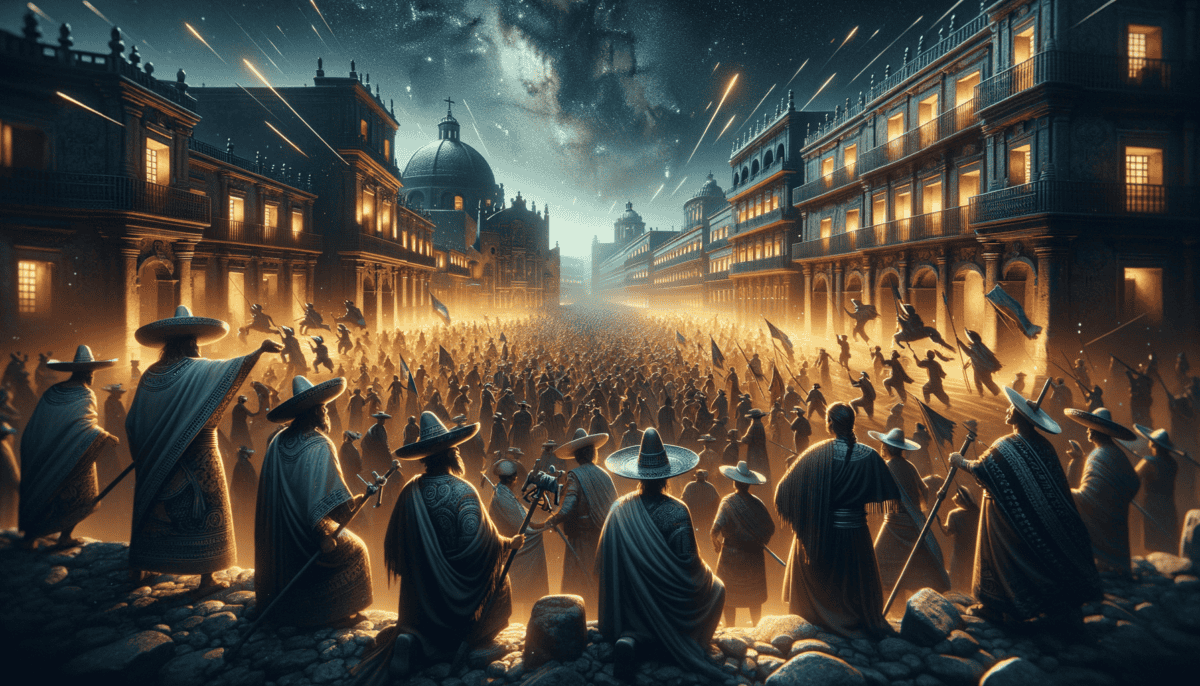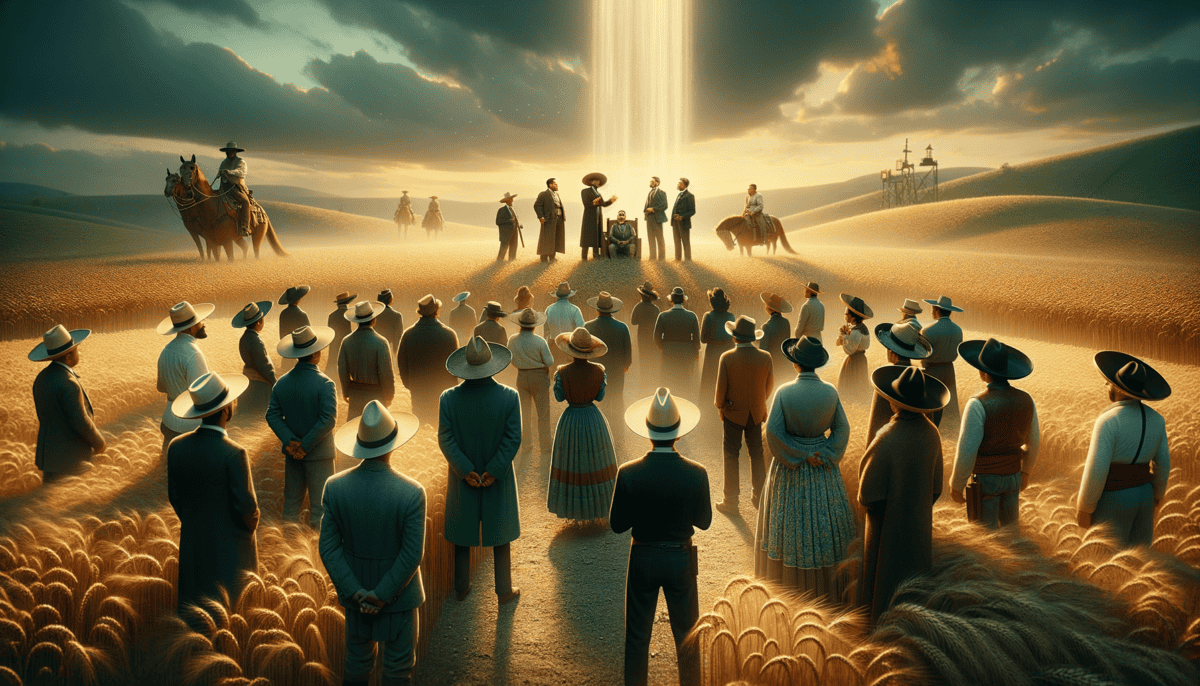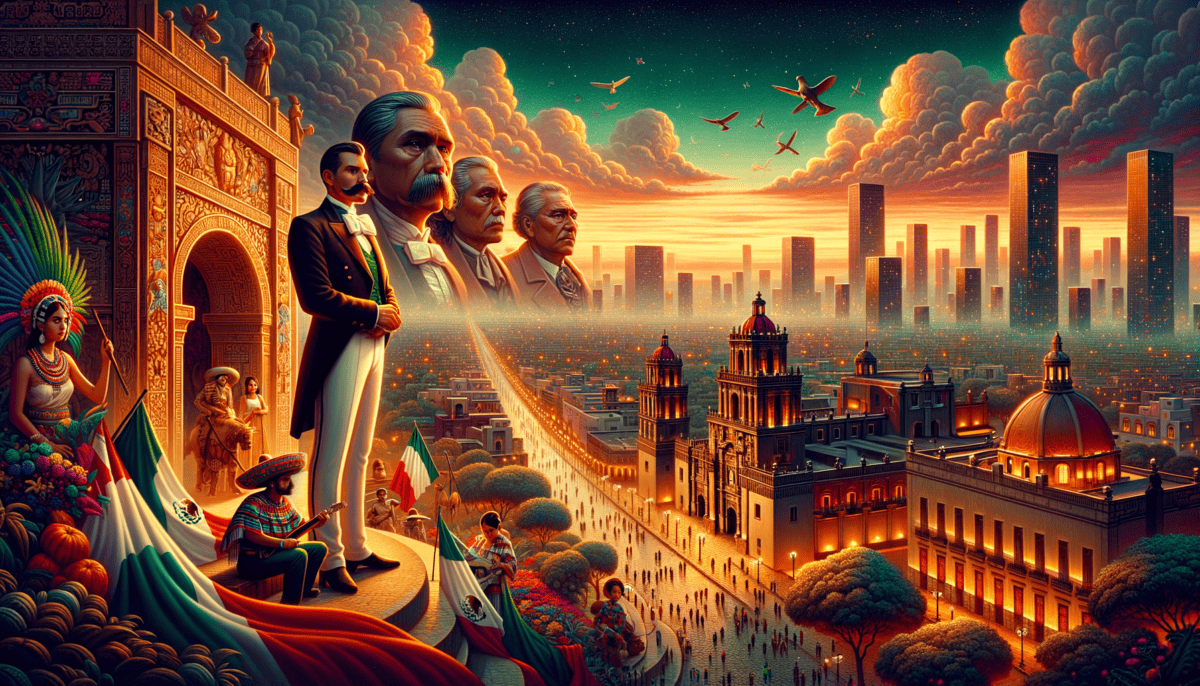The Land of the Jaguar Warriors
The sun rose over the mighty city of Tenochtitlan, painting the sky in beautiful shades of orange and pink. Young Yaotl stretched and gazed at the bustling marketplace below his window. The year was 1500, and the Aztec Empire was at its peak.
“Yaotl! Time for your training!” his father called. Today was special – Yaotl would begin his training to become a jaguar warrior, one of the most respected fighters in the Aztec army.
The marketplace was alive with sounds and smells. Colorful feathers from exotic birds decorated vendor stalls. Sweet fruits and spices filled the air. Yaotl loved walking through these streets, where merchants traded cacao beans like gold.
“Remember, my son,” his father said proudly, “our people built this great city on a lake. We are the children of the sun god Huitzilopochtli.”
Yaotl nodded, taking in the magnificent sight of their floating city. Tenochtitlan sat on an island in Lake Texcoco, connected to land by long causeways. Beautiful gardens floated on the water, growing food for the city’s people.
The most amazing things about the Aztec Empire were:
• Their floating gardens called chinampas
• Advanced writing system using pictures
• Complex calendar for farming
• Great pyramids and temples
• Schools for all children
At the training grounds, Yaotl met his teacher, Master Necalli. “Today,” the master announced, “you learn about our sacred jaguar warriors.”
Young warriors practiced with wooden swords in the courtyard. They moved like dancers, quick and strong. Yaotl watched in amazement as older students showed off their skills while wearing beautiful jaguar-skin suits.
“These suits,” Master Necalli explained, “give us the strength and courage of the mighty jaguar. But first, you must learn our ways.”
In the temple school called calmecac, Yaotl studied writing, history, and religion. He learned about other great civilizations like the Maya, who built incredible cities in the jungle and studied the stars. ⭐
That evening, Yaotl sat with his little sister, Citlali, watching the sunset over the great temple pyramid. “One day,” he said, “I will protect our beautiful city as a jaguar warrior.”
Citlali smiled. “Tell me again about the legend of our city’s founding,” she asked.
“Our ancestors traveled far to find the perfect place to build our home,” Yaotl began. “The gods told them to look for an eagle perched on a cactus, eating a snake. When they found this sign on an island in the lake, they knew they had found their home.”
As night fell over Tenochtitlan, thousands of torches lit up the city like stars. From the temple tops, priests watched the real stars, tracking time with their precise calendar. In the palace, nobles planned the next day’s activities, while in homes across the city, families shared stories of their proud heritage.
Master Necalli’s words echoed in Yaotl’s mind as he drifted off to sleep: “We are not just warriors, young one. We are the keepers of knowledge, the builders of cities, and the children of the gods.”

Conquest and Collision
The morning sun cast long shadows across Tenochtitlan as strange rumors spread through the marketplace. “Giant floating houses on water!” people whispered. “Men wearing metal shells!” It was 1519, and life as the Aztecs knew it was about to change forever.
Montezuma, the great Aztec emperor, stood on his palace balcony with his young advisor, Tonatiuh. “What do you see in these omens?” the emperor asked nervously.
“They come on the backs of deer without horns,” an old merchant reported, his voice shaking. “Their weapons make thunder!”
The Spanish ships had arrived on the coast, led by Hernán Cortés. The strangers wore shiny armor and rode horses – animals the Aztecs had never seen before. Young Tonatiuh watched as messengers raced through the city with news.
The most surprising things about the Spanish visitors were:
• Their metal armor that sparkled in the sun
• Horses that seemed like magical creatures
• Loud weapons called guns
• Ships bigger than any canoe
• Strange clothes and language
Little Maria, daughter of a Spanish soldier, watched wide-eyed as they entered the magnificent city. “Papa,” she whispered, “it’s like something from a dream!” The floating gardens, grand temples, and bustling markets amazed the Spanish newcomers.
“Look at all the gold,” her father muttered, his eyes gleaming with interest.
At first, the Aztecs welcomed the Spanish as guests. They showed them their beautiful city, their markets full of chocolate, corn, and colorful feathers. But things soon changed.
“These strangers bring sickness,” worried mothers whispered as a terrible disease called smallpox spread through the city. Many Aztecs became very sick because they had never faced this illness before.
Tonatiuh watched as tension grew between his people and the visitors. The Spanish wanted gold and didn’t understand the Aztec way of life. They didn’t like the Aztec gods or their ceremonies.
“Why do they not respect our ways?” Tonatiuh asked his grandmother.
“They come from a different world, child,” she answered softly. “They see things with different eyes.”
Fighting broke out in the streets. The Spanish weapons were strong, and they had help from other native groups who didn’t like Aztec rule. Tenochtitlan, the beautiful city on the lake, became a battlefield. ️
During this time, a special friendship formed between Tonatiuh and Maria. They taught each other their languages and shared stories about their different worlds.
“Your city is so amazing,” Maria said one day, looking at the floating gardens.
“And your horses are like creatures from legends,” Tonatiuh replied with a smile.
But their friendship was tested as the fighting got worse. The mighty Aztec Empire began to fall. By 1521, the Spanish had taken control, and a new chapter in Mexico’s story had begun.
Despite the sad changes, some beautiful things remained. The Spanish and Aztec cultures started to mix together. New foods, words, and customs were born. The people who came after would be neither fully Aztec nor fully Spanish, but something new – they would become the Mexican people.
As the sun set on the changed city, Tonatiuh told Maria, “Our worlds have crashed together like waves in a storm, but from this meeting, something new will grow.”

The Cry for Independence
The year was 1810, and change was in the air. In the small town of Dolores, Father Miguel Hidalgo paced in his church, thinking about his people’s suffering. The Spanish still ruled Mexico after many years, and things weren’t fair for most people.
Young Carlos, who helped at the church, watched Father Hidalgo with curious eyes. “Why do you look so worried, Father?” he asked.
“My child, sometimes we must be brave and stand up for what’s right,” Father Hidalgo replied, patting Carlos’s head.
Life was hard for many people in Mexico. The Spanish rulers made all the important choices and kept most of the money and land. People whose families had lived in Mexico for hundreds of years couldn’t have important jobs just because they weren’t born in Spain.
When people gathered at the church that morning, Father Hidalgo gave a special speech called the “Grito de Dolores” (The Cry of Dolores). These were the important things he said:
• Mexico should be free
• All people should be treated fairly
• The land should belong to those who work it
• Everyone should have better lives
“My father says we’re fighting for our tomorrow,” Carlos told his friend Maria, as they watched people join Father Hidalgo’s cause. Many carried farming tools as weapons and wore colorful bandanas.
The news spread like wildfire across Mexico. In town after town, people joined the fight for independence. They made flags with pictures of the Virgin of Guadalupe, who was very special to the Mexican people.
“Look how many people are joining!” Maria exclaimed, watching from her window as more fighters passed through their town.
But winning freedom wasn’t easy. The Spanish army was strong and had better weapons. After some big wins, Father Hidalgo was caught and lost his life for the cause. But his dream didn’t die – other brave leaders like José María Morelos continued the fight.
Carlos grew older during these hard years. He helped carry messages between rebel groups and saw how people never gave up hope. “Even when things look dark,” his father told him, “remember that the sun always rises again.”
Years passed, and the fight continued. Different groups of people worked together: rich and poor, city folks and farmers, all wanting the same thing – a free Mexico. Young soldiers like Vicente Guerrero kept the dream alive.
“What will Mexico be like when we’re free?” Maria asked Carlos one evening.
“It will be a place where everyone has a chance to be happy,” Carlos answered with hope in his eyes.
Finally, after 11 long years of fighting, Mexico won its independence in 1821. The last Spanish ruler signed an agreement called the Treaty of Córdoba, and Mexico became its own country!
In the town square, Carlos, now a young man, watched as people celebrated. Children danced, music played, and the new Mexican flag flew proudly in the wind.
“Father Hidalgo would be so happy to see this,” an old woman said, wiping tears from her eyes.
The people had won their freedom, but they knew their journey wasn’t over. Now they had to build their new country together, making Father Hidalgo’s dream of a fair and free Mexico come true.
As the celebrations continued into the night, Carlos looked up at the stars and smiled, knowing that this was just the beginning of Mexico’s story as a free nation.

Revolution and Reform
The sun rose over Mexico in 1910, and people were ready for big changes. Poor farmers worked on huge farms called haciendas, but they didn’t own the land. Most of the country’s wealth belonged to a few rich families, while many people lived in tiny homes with little food.
“Papa, why do we work so hard but still have so little?” young Rosa asked her father as they worked in the fields.
“Things aren’t fair, mi hija,” her father replied, wiping sweat from his brow. “But brave people are working to change that.”
A man named Francisco Madero wanted everyone to have better lives. He spoke about freedom and fair elections. His words spread through towns and villages like wildfire.
Zapata had a simple but powerful idea: “Land and Liberty!” He believed farmers should own the fields they worked in. Pancho Villa led an army of cowboys and workers, fighting for the same dream.
“Look!” Rosa pointed excitedly one day. “The revolutionaries are coming!” Their village buzzed with excitement as Zapata’s soldiers rode through, their horses kicking up dust.
A young soldier named Miguel shared his story with Rosa’s family over dinner: “I joined Zapata because I want my children to have a better life than I did. We’re not just fighting – we’re building a new Mexico.”
The revolution wasn’t just about fighting. People wanted:
• Fair treatment for workers
• Schools for children
• Land for farmers
• Better lives for everyone
Rosa helped by carrying messages between revolutionary groups. She saw how women joined the fight too – they were called “Adelitas” and were just as brave as the men.
“Mamá, tell me about the Adelitas again,” Rosa would ask at bedtime.
“They were strong women who fought for our future,” her mother would say proudly. “They carried guns, cooked for the soldiers, and took care of the wounded.”
The fighting was hard and lasted many years. But slowly, things began to change. Workers got better pay and shorter work days. Children could go to school instead of working in fields. Farmers started getting their own land.
One morning, Rosa’s father gathered the family. “Look!” he said, showing them a paper. “This land is now ours!” Their family finally had their own farm to work on, just as Zapata had promised.
The revolution brought many good changes to Mexico. Artists painted big, beautiful murals telling the story of the revolution on walls. Musicians wrote songs about the brave fighters. People felt proud to be Mexican.
“What did we learn from the revolution?” Rosa’s teacher asked her class.
Rosa stood up tall: “We learned that when people work together, they can make big changes happen!”
Years later, Rosa would tell her own children about the revolution. She would point to the land their family farmed and say, “This is what our brave revolutionaries fought for – so we could all have a better life.” ✨
The Mexican Revolution changed the country forever. It showed that regular people – farmers, workers, and families – could stand up and make their country better. Their courage and dreams helped build the Mexico we know today.

Building a New Nation
The sun shone brightly over Mexico City in 1920. After the big revolution, it was time to build a better country. People were excited about new chances to make their dreams come true.
Little Carlos lived with his family in the growing city. One morning, he watched workers painting huge pictures on the walls of buildings.
“What are they doing, Papá?” Carlos asked.
“They’re telling Mexico’s story through art, mijo,” his father explained. “Those are murals by Diego Rivera and other artists. They help us remember where we came from.”
• New schools opened everywhere
• Workers got better jobs
• Farmers owned their land
• Cities grew bigger
• Art and music filled the streets
Carlos loved going to his new school. Before the revolution, many kids couldn’t go to school at all. Now, bright classrooms were full of children learning to read and write.
“Teacher, why is education so important?” Carlos asked one day.
“Because knowledge gives us power to build a better future,” she smiled. “That’s what our revolution was all about.”
The city was changing fast. New buildings reached toward the sky. Cars and buses replaced old horse carts. Radios brought music and news into people’s homes. ⚡
Carlos’s mother started her own small shop selling colorful rebozos (shawls). “Now women can vote and own businesses,” she told Carlos proudly. “We’re part of building the new Mexico too!”
One day, Carlos visited his grandfather’s farm outside the city. The old man showed him the land certificate on the wall.
“This paper means our family owns this land,” his grandfather said. “Before the revolution, only rich people owned land. Now it belongs to the farmers who work it.”
Mexico was growing stronger. The country found oil underground, which helped build more roads and schools. Mexican movies and music became famous around the world.
“Look at the newspaper!” Carlos’s father announced one morning. “Mexico is hosting big sports games called the Olympics! The whole world will see our beautiful country.”
Artists kept painting Mexico’s story. Writers wrote books about their country. Scientists made new discoveries. Everyone was helping Mexico grow.
Sometimes there were hard times too. Not everything changed as fast as people hoped. But Mexicans remembered the spirit of the revolution – working together makes big dreams possible.
At school, Carlos and his friends sang new songs about Mexico. They learned about their country’s heroes and drew pictures of what they wanted Mexico to become.
“What do you want to be when you grow up?” Carlos’s teacher asked the class.
“I want to be a builder,” Carlos said. “I want to help make Mexico even better!” ️
The whole country was like a big family working together. People remembered the brave revolutionaries while building new dreams. Mexico was becoming stronger and more beautiful every day.
That night, looking at the city lights from his window, Carlos felt proud. His country had come so far, and the future looked bright with possibility. ✨

Dreams for Tomorrow
The Mexico of today shines bright, like the stars over Mexico City. Maria, a young girl with big dreams, walks through her neighborhood, where old traditions dance with new ideas.
“Abuela, tell me again about how different Mexico was when you were little,” Maria asks her grandmother while helping make tamales in their cozy kitchen.
“Ay, mijita,” Abuela smiles, patting masa onto corn husks. “When I was your age, we didn’t have computers or phones. But we had something special – hope for a better Mexico.”
Maria sees this better Mexico everywhere she looks. Her mother is a scientist working on clean energy. Her father teaches children how to code. Her brother plays in a band that mixes traditional Mexican music with modern beats.
• World-famous art and culture
• Strong friendships with other countries
• New technology and innovation
• Care for nature and history
• Pride in Mexican traditions
At school, Maria learns about space technology being developed in Mexico. “Did you know Mexican scientists help build satellites?” her teacher says proudly. “And our ancient Maya ancestors were great astronomers too!”
Walking home, Maria passes colorful street art next to ancient pyramids. She sees tourists taking pictures of both. Mexico’s past and future live side by side, like old friends.
“Look!” Maria points to workers installing solar panels. “Just like in Mamá’s lab!”
“Si, mi amor,” her father nods. “Mexico is helping fight climate change. We’re protecting the Earth for your future.”
In the plaza, Maria watches indigenous dancers perform near a modern shopping center. Their feathers and bells tell stories as old as the mountains, while nearby teenagers snap photos on their phones.
Mexican movies win awards around the world. Mexican food makes people happy everywhere. Mexican artists paint new dreams in bright colors.
“We’re writing Mexico’s next chapter,” Maria’s teacher often says. “What will your part of the story be?”
Maria thinks about this as she helps her grandmother in their small garden. They grow herbs used in both ancient medicine and modern cooking.
“The secret,” Abuela says, “is remembering where we came from while growing toward tomorrow.”
From the ancient Aztecs to today’s young dreamers like Maria, Mexico’s story is about brave people working together. Through hard times and good times, Mexicans keep their culture strong while building new dreams.
As the sun sets over Mexico City, Maria writes in her diary: “Mexico is like a beautiful tree. Its roots are deep in history, its trunk is strong with tradition, and its branches reach high toward the future.”
And just like Maria’s tree, Mexico keeps growing, reaching higher, spreading its branches wider, making room for new dreams while holding tight to its precious roots. The story of Mexico continues, written by millions of hands, sung by millions of voices, loved by millions of hearts.
Tomorrow brings new chapters, new challenges, and new victories. But one thing stays the same – the spirit of Mexico, strong and proud, lighting the way forward like stars in the night sky. ✨

